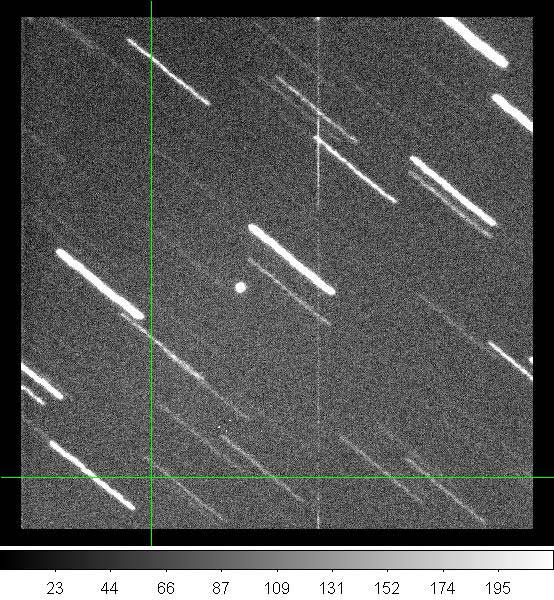Tiny Asteroid That Buzzed Earth Is a Fast-Spinning Rock

A small asteroid that zipped by the Earth this week has turned out to be no slow poke. It is the second-fastest spinning asteroid ever seen, astronomers say.
The space rock, called asteroid 2010 WA, flew within 24,000 miles (38,000 kilometers) of Earth Tuesday night (Nov. 16). [Photo of asteroid 2010 WA]
The asteroid was tiny, just 10 feet (3 meters) across and posed no threat of hitting Earth. In fact, it was so small that it would break apart before passing through Earth's atmosphere, NASA scientists said.
But the relative harmlessness of asteroid 2010 WA did not make it any less interesting to scientists.
Astronomers with the Magdalena Ridge Observatory near Socorro, N.M., trained a 2.4-meter telescope on the asteroid as it sailed past the Earth Tuesday at 10:44 p.m. EST (0344 Nov. 17 GMT).
What they found was surprising.
"We measured the rotation rate of the asteroid at about 31 seconds," astronomer Eileen Ryan, the observatory's director, told SPACE.com in an e-mail. "This makes it the second fastest rotating asteroid discovered to date."
Get the Space.com Newsletter
Breaking space news, the latest updates on rocket launches, skywatching events and more!
The fastest spinning asteroid currently known is an asteroid called 2010 JL88, which spins once every 24.5 seconds and was also discovered using Magdalena Ridge Observatory's telescope, Ryan said.
Despite its small size, the asteroid still appeared as a bright object on a dark background in images taken by the observatory's telescope, which is built for tracking near-Earth objects (NEOs) and satellites, Ryan said.
"Because of this unusual feature, tracking fast-moving NEOs like 2010 WA is fairly easy for us," Ryan said.
The next time asteroid 2010 WA will come anywhere near Earth's cosmic neighborhood is in September 2013, but that pass will be considerably farther - about the equivalent of the distance between the Earth and the sun (93 million miles, or 150 million km), Ryan added.
Asteroid 2010 WA was the fourth space rock in three months to zip by the Earth within the orbit of the moon.
On Oct. 12, the asteroid 2010 TD54 passed Earth at nearly the same miss distance as 2010 WA. A month earlier astronomers caught a rare sighting of two asteroids — known as 2010 RX30 and 2010 RF12 — when they both passed within the moon's orbit on the same day (Sept. 8).
NASA regularly tracks asteroids and comets that fly near Earth as part of the Near-Earth Object Observations program. The monitoring program uses a network of ground and space telescopes to monitor the space rock environment around the planet.
To date, the program has tracked about 85 percent of the largest asteroids that fly near Earth and 15 percent of asteroids around 460 feet (140 m) across, according to the latest tally.
The U.S. space agency also plans to send astronauts to an asteroid by 2025 under a space plan ordered by President Obama. Such a mission could help scientists better understand the makeup of asteroids and to determine better means of deflecting them before they pose a threat to Earth, agency officials have said.
Reach SPACE.com managing editor Tariq Malik at tmalik@space.com. Follow him on Twitter @tariqjmalik.
Join our Space Forums to keep talking space on the latest missions, night sky and more! And if you have a news tip, correction or comment, let us know at: community@space.com.

Tariq is the Editor-in-Chief of Space.com and joined the team in 2001, first as an intern and staff writer, and later as an editor. He covers human spaceflight, exploration and space science, as well as skywatching and entertainment. He became Space.com's Managing Editor in 2009 and Editor-in-Chief in 2019. Before joining Space.com, Tariq was a staff reporter for The Los Angeles Times covering education and city beats in La Habra, Fullerton and Huntington Beach. In October 2022, Tariq received the Harry Kolcum Award for excellence in space reporting from the National Space Club Florida Committee. He is also an Eagle Scout (yes, he has the Space Exploration merit badge) and went to Space Camp four times as a kid and a fifth time as an adult. He has journalism degrees from the University of Southern California and New York University. You can find Tariq at Space.com and as the co-host to the This Week In Space podcast with space historian Rod Pyle on the TWiT network. To see his latest project, you can follow Tariq on Twitter @tariqjmalik.
